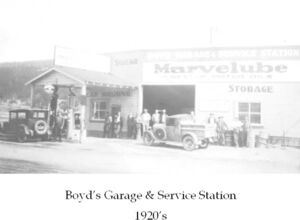It was all about getting there ‘up the Cariboo road’
“There” being the goldfields. There were several routes to riches. The “River Trail” which wound along the cliffs and benches of the Fraser from Lillooet to Big Bar, was passable, just barely, to mules and small pack trains. It lacked water and feed for traveller’s stock. The “old” Cariboo Road was extended from the “Lakes Route”, 224 miles (360 Km) from Lillooet, over Pavilion Mountain, through Clinton, and north to Alexandria. Built by the Royal Engineers in 1862, this was the first practical wagon access to the Cariboo.

Typical freight outfit at the Lone Pine, junction of the ‘old’ and ‘new’ Cariboo Wagon Roads. This tree stood for many years at the junction of the old & new Wagon Roads in Clinton.

This photo shows a very common configuration for many of the freighters who moved millions of pounds of cargo up the Cariboo Road. An eight horse hitch pulled two wagons, close coupled in tandem, and a two wheeled “pup”. The wagons, like the Botterill wagon at our museum, could haul from three to six thousand pounds, (1300 to 2800 KG). Each!
The pup might be used for the teamster’s camping gear, but it was much more likely to be used for a few more pounds of revenue generating freight. (Teamsters routinely slept under their wagons)
Although freight rates had dropped from $.90/pound to $.50/pound by 1864, a trip to Barkerville could still gross over $5,000. Of course, feed for the stock, repairs to the equipment, and accommodations for the teamsters cost money, but there was still a lot of money made freighting up the Cariboo Road.
















